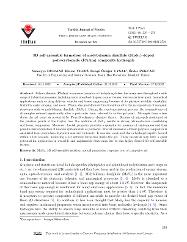| dc.contributor.author | Durmaz, Sumeyye | |
| dc.contributor.author | Yildiz, Ekrem | |
| dc.contributor.author | Uysal, Bengu Ozugur | |
| dc.contributor.author | Pekcan, Onder | |
| dc.date.accessioned | 2023-10-19T15:12:54Z | |
| dc.date.available | 2023-10-19T15:12:54Z | |
| dc.date.issued | 2022 | |
| dc.identifier.issn | 1300-0101 | |
| dc.identifier.issn | 1303-6122 | |
| dc.identifier.uri | https://doi.org/10.55730/1300-0101.2730 | |
| dc.identifier.uri | 1147599 | |
| dc.identifier.uri | https://hdl.handle.net/20.500.12469/5558 | |
| dc.description.abstract | Polyacrylamide (PAAm), a renowned member of the hydrogel class, has many uses throughout a wide range of industrial processes, including water absorbed diapers, contact lenses, wastewater treatment, biomedical applications such as drug delivery vehicles and tissue engineering because of its physical stability, durability, flexibility easier shaping, and so on. PAAm also provides new functionalities after the incorporation of inorganic structures such as molybdenum disulfide (MoS2). During the copolymerization process, the transmittance of all samples reduced significantly after a particular time, referred to as the gel point. Microgels form a tree above the gel point as projected by Flory-Stockmayer classical theory. Because of microgels positioned at the junction points of the Cayley tree, the addition of MoS2 results in strong intramolecular crosslinking and looser composites. Moreover, fractal geometry provides a quantitative measure of randomness and thus permits characterization of random systems such as polymers. Fractal dimension of these polymer composites is calculated from power-law-dependent scattered intensity. It was also confirmed that a hydrogel rapidly formed within a few seconds, indicating a 3D network formation inside the gel. These materials may have a great potential for application in wearable and implantable electronics due to this highly desired 3D self-assemble feature. | en_US |
| dc.language.iso | eng | en_US |
| dc.publisher | Tubitak Scientific & Technological Research Council Turkey | en_US |
| dc.relation.ispartof | Turkish Journal of Physics | en_US |
| dc.rights | info:eu-repo/semantics/openAccess | en_US |
| dc.subject | Molecular-Size Distribution | En_Us |
| dc.subject | Layer Mos2 | En_Us |
| dc.subject | Polymers | En_Us |
| dc.subject | Gelation | En_Us |
| dc.subject | MoS2 | en_US |
| dc.subject | 3D self-assemble gelation | en_US |
| dc.subject | optical properties | en_US |
| dc.subject | response rate of composite gel | en_US |
| dc.title | 3D self-assemble formation of molybdenum disulfide (MoS2)-doped polyacrylamide (PAAm) composite hydrogels | en_US |
| dc.type | article | en_US |
| dc.identifier.startpage | 239 | en_US |
| dc.identifier.endpage | 251 | en_US |
| dc.authorid | PEKCAN, Onder/0000-0002-0082-8209 | |
| dc.identifier.issue | 6 | en_US |
| dc.identifier.volume | 46 | en_US |
| dc.department | N/A | en_US |
| dc.identifier.wos | WOS:000906390000007 | en_US |
| dc.identifier.doi | 10.55730/1300-0101.2730 | en_US |
| dc.identifier.scopus | 2-s2.0-85146975200 | en_US |
| dc.institutionauthor | N/A | |
| dc.relation.publicationcategory | Makale - Uluslararası Hakemli Dergi - Kurum Öğretim Elemanı | en_US |
| dc.authorwosid | Durmaz, Sumeyye/HLX-1986-2023 | |
| dc.authorwosid | PEKCAN, Onder/Y-3158-2018 | |
| dc.identifier.trdizinid | https://search.trdizin.gov.tr/yayin/detay/1147599 | en_US |
| dc.khas | 20231019-WoS | en_US |
















